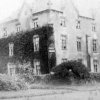
Page
Out
Records
Kerry
Links
 | ||||
| Home Page | Starting Out | Online Records | Research Kerry | Resource Links |
| Castles | Country Homes | ||||
(Early Stone Fortifications - Castles, Towers and Strong-Houses)
Castle Name - Location - Early Founder - Time Period Contructed
Ardea Castle - Co. Kerry - O'Sullivan Beare - 13th? century tower-house
Ballingarry - mouth of the Shannon, Co. Kerry - Cantillon (1280)
Ballinskelligs - Co. Kerry - MacCarthy - 16th century
Ballybunion Castle - Co Kerry - FitzMaurice - 14th century
Ballycarbery - Co. Kerry - MacCarthy Mor (O'Connell) - 15th century
Ballymalis Castle- Co. Kerry - O'Moriarity, Ferris - 4 story, 16th century tower
Carrigafoyle - Co. Kerry - O'Conor Kerry- 15th century tower-house
Carrignass Castle - Co. Kerry - O'Sullivan (c1540)
Castle of the Island - Co. Kerry - - (1220)
Dunbeg Promontory Fort - Co. Kerry - 10th century
Dunkerron - Co. Kerry - O'Sullivan Mor - early Anglo-Norman tower
Dunloe Castle - Beaufort, Co. Kerry - Fitzgerald (c1215)- 17th century strong-house
Gallarus - Co. Kerry - Knight of Kerry - 16th century tower
Listowell (FitzMaurice) Castle - Co. Kerry - McGilligan, FitzMaurice - 15th century
Minard - Co. Kerry - tower
Castle of Parkvonear - Aghadoe, Co. Kerry - 13th century? round tower
Ross Castle - (here too) Killarney, Co. Kerry - O'Donoghue Mor, Browne - 15th/16th century
Skellig Michael - Co. Kerry - island monastic site (also see here)
Straigue Fort - Iveragh Peninsula, Co. Kerry - early ring fort
Castle Sybil - Co. Kerry - Ferriter
 Built by Sir William Godfrey, 1st Bart., M.P. Altered ca. 1830 by Sir John Godfrey. The Godfreys here till 1960. M. Bence-Jones, A Guide to Irish Country Houses, London, 1988. Photo: Kilcoleman Abbey c. 1900
Built by Sir William Godfrey, 1st Bart., M.P. Altered ca. 1830 by Sir John Godfrey. The Godfreys here till 1960. M. Bence-Jones, A Guide to Irish Country Houses, London, 1988. Photo: Kilcoleman Abbey c. 1900 * Contributor John G Knightly shares this information: "Bushfield House, known as Kilcoleman Abbey from circa 1820, was remodeled for the first Baronet, Sir William Godfrey in the 1770's after the original Bushfield House was destroyed by fire. Recent research indicates that the new Bushfield was constructed from the remains of an older tower house on lands that originally belonged to the MacCarthy Mor. More or less abandoned from 1800 to 1818, the house was renovated under the second Baronet, Sir John Godfrey, according to ambitious plans drawn up by the famous architect, William Vitruvius Morrison. However the general economic decline of the 1820's and family misfortunes meant that only the stables and service wing, with its flemish gables, were completed as planned. Later, in the early 1840's, the third Baronet Sir William Duncan Godfrey further modified the main block of the house, adding an attic storey, a turret emblazoned with the Red Hand of Ulster, the traditional shield of a Baronet and assorted gables, pinnacles and buttresses. Inside the main reception rooms were remodeled in the then popular Gothic style with fine plasterwork by local craftmen, making liberal use of the Godfrey crest. The entrance hall was dominated by a fine bust of Eleanor, Lady Godfrey carved in Florence in 1817. The house was the centre of a 6,000-acre estate and was lived in continually by the Godfrey family until 1958. The last owner, Miss Phyllis Godfrey, confronted by a dreadful infestation of dry rot, was eventually forced to abandon the house for the gate lodge where she died in December 1959. The house was eventually demolished in the 1970's despite some valiant attempts to save it."